hungary
1698, Hungary, Emperor Leopold I the Hogmouth. Gold 1/6 Ducat Coin. PCGS MS66
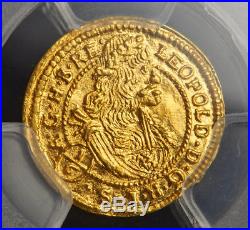
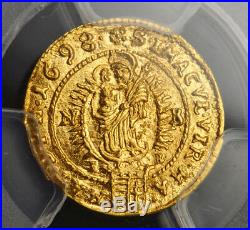
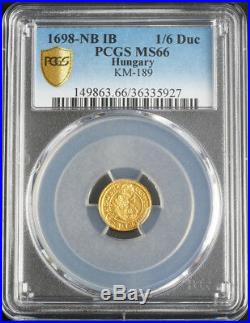
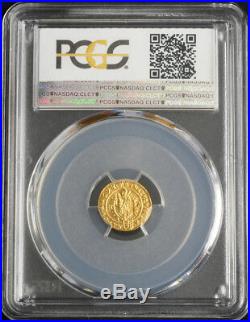

1698, Hungary, Emperor Leopold I “the Hogmouth”. Gold 1/6 Ducat Coin. Mint Year: 1698 Denomination: 1/6 Ducat Mint Official: J. Mint Place: Nagybanya (N-B) Ruler: Leopold I “the Hogmouth”. Reference: Friedberg 154, KM-189. Certified and graded by PCGS as MS-66 None higher or equal at PCGS and only one in this designation at NGC! Diameter: 13mm Weight: 0.57gm Material: Silver. Obverse: Wreathed and draped bust of Emperor Leopold I right. Fractional ducat value (1/6) in legend below shoulder. Reverse: The Virgin (Madonna) and baby-Jesus child standing on crescent, surrounded by light. Mint initials (N-B) and mint offiicial´s letters (I-B) at sides. Crowned Hungarian arms splitting legend below. Leopold I, Holy Roman Emperor name in full. Leopold Ignaz Joseph Balthasar Felician. Habsburg (June 9, 1640 May 5, 1705), Holy Roman emperor, was the second son of the emperor Ferdinand III and his first wife Maria Anna of Spain. His maternal grandparents were Philip III of Spain and Margarita of Austria. He was a younger brother of Ferdinand IV of Hungary and Mariana of Austria. Intended for the Church, he received a good education but his prospects were changed by the death of his elder brother Ferdinand IV, on July 9, 1654 of smallpox, when he became his father’s heir. Leopold was physically unprepossessing. Short and sickly, he had inherited the Habsburg lip to a degree unusual even in his inbred family. One contemporary said of him “His gait was stately, slow and deliberate; his air pensive, his address awkward, his manner uncouth, his disposition cold and phlegmatic”. In 1655 he was chosen king of Hungary and in 1656 king of Bohemia, 1657 king of Croatia and in July 1658, more than a year after his father’s death, he was elected emperor at Frankfurt in spite of the intrigues of Jules Cardinal Mazarin, who wished to place on the imperial throne Ferdinand Maria, Elector of Bavaria or some other prince whose elevation would break the Habsburg succession. Mazarin, however, obtained a promise from the new emperor that he would not send assistance to Spain, then at war with France, and, by joining a confederation of German princes, called the league of the Rhine, France secured a certain influence in the internal affairs of Germany. Leopold’s long reign covers one of the most important periods of European history; for nearly the whole of its forty-seven years he was pitted against Louis XIV of France, whose dominant personality completely overshadowed Leopold. The emperor was not himself a man of war, and never led his troops in person; yet the greater part of his public life was spent in arranging and directing wars. The first was with Sweden, whose king Charles X found a useful ally in the prince of Transylvania, György II Rákóczi, a rebellious vassal of the Hungarian crown. This war, a legacy of the last reign, was waged by Leopold as the ally of Poland until peace was made at Oliva in 1660. A more dangerous foe next entered the lists. The Ottoman Empire interfered in the affairs of Transylvania, always an unruly district, and this interference brought on a war with the Holy Roman Empire, which after some desultory operations really began in 1663. By a personal appeal to the diet at Regensburg Leopold induced the princes to send assistance for the campaign; troops were also sent by France, and in August 1664 the great imperialist general, Raimondo Montecuccoli, gained a notable victory at Saint Gotthard. By the Peace of Vasvár the emperor made a twenty years’ truce with the sultan, granting more generous terms than his recent victory seemed to render necessary. The item “1698, Hungary, Emperor Leopold I the Hogmouth. Gold 1/6 Ducat Coin. PCGS MS66″ is in sale since Wednesday, December 19, 2018. This item is in the category “Coins & Paper Money\Coins\ World\Gold”. The seller is “coinworldtv” and is located in Europe. This item can be shipped worldwide.
- Grade: MS66
- Certification: PCGS
- Composition: Gold
- Year: 1698
- Certification Number: 36335927

1458, Hungary, Mathias Corvinus. Rare Gold Gulden (Ducat) Coin. Gem! PCGS MS-64
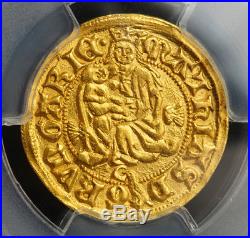
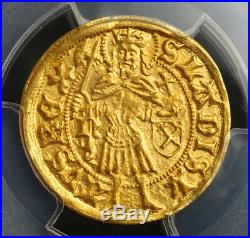
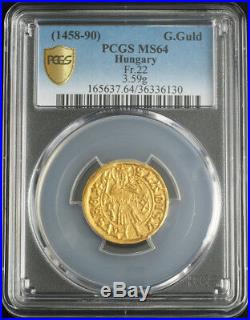
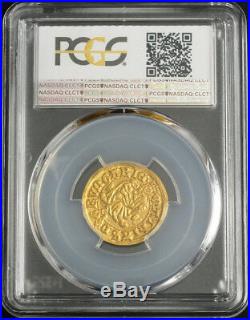

1458, Hungary, Mathias Corvinus. Rare Gold Gulden (Ducat) Coin. Certified and graded by PCGS as MS-64! Reference: Friedberg 22, Pohl K15-6, Huszar 680. Denomination: Gold Ducat / Gold Gulden. Mint Place: Nagybanya (n, today´s Baia Mare, Romania) Mint master (Kammergraf): Thomas Altemberger, Bürgermeister. Diameter: 21mm Weight: 3.49gm Material: Gold! Obverse: Saint Ladislaus I standing facing, holding ax and globus cruciger. Mint initial (n) and privy mark (shield with crossed hammers) of the mint official (Thmas Altemberger) in fields. REX Reverse: Crowned Holy Virgin enthroned facing, cradling Holy Infant; thistle head to either side. Legend: + MATTHIAS D (raven with ring in beak) G R VNGARIE. 1040 29 July 1095 was King of Hungary from 1077 until his death, “who greatly expanded the boundaries of the kingdom and consolidated it internally; no other Hungarian king was so generally beloved by the people”. Before his ascension to the throne, he was the main advisor of his brother, Géza I of Hungary, who was fighting against their cousin, King Solomon of Hungary. When his brother died, his followers proclaimed Ladislaus king according to the Hungarian tradition that gave precedence to the eldest member of the royal family to the deceased king’s sons. Following a long period of civil wars, he strengthened the royal power in his kingdom by introducing severe legislation. He also could expand his rule over Croatia. After his canonisation, Ladislaus became the model of the chivalrous king in Hungary. Matthias Corvinus , also called Matthias I Hungarian. 23 February 1443 6 April 1490, was King of Hungary and Croatia from 1458 to 1490. After conducting several military campaigns, he was elected King of Bohemia in 1469 and adopted the title Duke of Austria in 1487. He was the son of John Hunyadi, Regent of Hungary, who died in 1456. In 1457, Matthias was imprisoned along with his older brother, Ladislaus Hunyadi, on the orders of King Ladislaus V of Hungary. Ladislaus Hunyadi was executed, causing a rebellion that forced King Ladislaus to flee Hungary. After the King died unexpectedly, Matthias’s uncle Michael Szilágyi persuaded the Estates to unanimously proclaim Matthias king on 24 January 1458. He began his rule under his uncle’s guardianship, but he took effective control of government within two weeks. As king, Matthias waged wars against the Czech mercenaries who dominated Upper Hungary (today parts of Slovakia and Northern Hungary) and against Frederick III, Holy Roman Emperor, who claimed Hungary for himself. In this period, the Ottoman Empire conquered Serbia and Bosnia, terminating the zone of buffer states along the southern frontiers of the Kingdom of Hungary. Matthias signed a peace treaty with Frederick III in 1463, acknowledging the Emperor’s right to style himself King of Hungary. In this year, Matthias invaded the territories that had recently been occupied by the Ottomans and seized fortresses in Bosnia. He soon realized he could expect no substantial aid from the Christian powers and gave up his anti-Ottoman policy. These measures caused a rebellion in Transylvania in 1467, but he subdued the rebels. The next year, Matthias declared war on George of Podbrady, the Hussite King of Bohemia, and conquered Moravia, Silesia, and Lausitz, but he could not occupy Bohemia proper. The Catholic Estates proclaimed him King of Bohemia on 3 May 1469, but the Hussite lords refused to yield to him even after the death of their leader George of Podbrady in 1471. Instead, they elected Vladislaus Jagiellon, the eldest son of Casimir IV of Poland. A group of Hungarian prelates and lords offered the throne to Vladislaus’s younger brother Casimir, but Matthias overcame their rebellion. Having routed the united troops of Casimir IV and Vladislaus at Breslau in Silesia (now Wrocaw in Poland) in late 1474, Matthias turned against the Ottomans, who had devastated the eastern parts of Hungary. He sent reinforcements to Stephen the Great, Prince of Moldavia, enabling Stephen to repel a series of Ottoman invasions in the late 1470s. In 1476, Matthias besieged and seized abac, an important Ottoman border fort. He concluded a peace treaty with Vladislaus Jagiellon in 1478, confirming the division of the Lands of the Bohemian Crown between them. Matthias waged a war against Emperor Frederick and occupied Lower Austria between 1482 and 1487. Matthias established a professional army (the Black Army of Hungary), reformed the administration of justice, reduced the power of the barons, and promoted the careers of talented individuals chosen for their abilities rather than their social statuses. Matthias patronized art and science; his royal library, the. Was one of the largest collections of books in Europe. With his patronage, Hungary became the first country to embrace the Renaissance from Italy. As Matthias the Just, the monarch who wandered among his subjects in disguise, he remains a popular hero of Hungarian folk tales. The item “1458, Hungary, Mathias Corvinus. Rare Gold Gulden (Ducat) Coin. Gem! PCGS MS-64″ is in sale since Wednesday, December 19, 2018. This item is in the category “Coins & Paper Money\Coins\ World\Gold”. The seller is “coinworldtv” and is located in Europe. This item can be shipped worldwide.
- Certification: PCGS
- Certification Number: 36336130
- Year: 1458-1490
- Grade: MS64
- Composition: Gold
